Intel Core i7-10700 vs Core i7-10700K Review: Is 65W Comet Lake an Option?
by Dr. Ian Cutress on January 21, 2021 10:30 AM EST- Posted in
- CPUs
- Intel
- Core i7
- Z490
- 10th Gen Core
- Comet Lake
- i7-10700K
- i7-10700
CPU Tests: Rendering
Rendering tests, compared to others, are often a little more simple to digest and automate. All the tests put out some sort of score or time, usually in an obtainable way that makes it fairly easy to extract. These tests are some of the most strenuous in our list, due to the highly threaded nature of rendering and ray-tracing, and can draw a lot of power. If a system is not properly configured to deal with the thermal requirements of the processor, the rendering benchmarks is where it would show most easily as the frequency drops over a sustained period of time. Most benchmarks in this case are re-run several times, and the key to this is having an appropriate idle/wait time between benchmarks to allow for temperatures to normalize from the last test.
Blender 2.83 LTS: Link
One of the popular tools for rendering is Blender, with it being a public open source project that anyone in the animation industry can get involved in. This extends to conferences, use in films and VR, with a dedicated Blender Institute, and everything you might expect from a professional software package (except perhaps a professional grade support package). With it being open-source, studios can customize it in as many ways as they need to get the results they require. It ends up being a big optimization target for both Intel and AMD in this regard.
For benchmarking purposes, we fell back to one rendering a frame from a detailed project. Most reviews, as we have done in the past, focus on one of the classic Blender renders, known as BMW_27. It can take anywhere from a few minutes to almost an hour on a regular system. However now that Blender has moved onto a Long Term Support model (LTS) with the latest 2.83 release, we decided to go for something different.
We use this scene, called PartyTug at 6AM by Ian Hubert, which is the official image of Blender 2.83. It is 44.3 MB in size, and uses some of the more modern compute properties of Blender. As it is more complex than the BMW scene, but uses different aspects of the compute model, time to process is roughly similar to before. We loop the scene for at least 10 minutes, taking the average time of the completions taken. Blender offers a command-line tool for batch commands, and we redirect the output into a text file.

The 10700K takes a small lead.
Corona 1.3: Link
Corona is billed as a popular high-performance photorealistic rendering engine for 3ds Max, with development for Cinema 4D support as well. In order to promote the software, the developers produced a downloadable benchmark on the 1.3 version of the software, with a ray-traced scene involving a military vehicle and a lot of foliage. The software does multiple passes, calculating the scene, geometry, preconditioning and rendering, with performance measured in the time to finish the benchmark (the official metric used on their website) or in rays per second (the metric we use to offer a more linear scale).
The standard benchmark provided by Corona is interface driven: the scene is calculated and displayed in front of the user, with the ability to upload the result to their online database. We got in contact with the developers, who provided us with a non-interface version that allowed for command-line entry and retrieval of the results very easily. We loop around the benchmark five times, waiting 60 seconds between each, and taking an overall average. The time to run this benchmark can be around 10 minutes on a Core i9, up to over an hour on a quad-core 2014 AMD processor or dual-core Pentium.
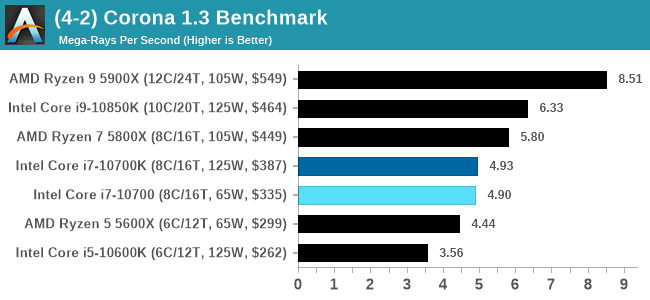
The 10700K takes a small lead.
Crysis CPU-Only Gameplay
One of the most oft used memes in computer gaming is ‘Can It Run Crysis?’. The original 2007 game, built in the Crytek engine by Crytek, was heralded as a computationally complex title for the hardware at the time and several years after, suggesting that a user needed graphics hardware from the future in order to run it. Fast forward over a decade, and the game runs fairly easily on modern GPUs.
But can we also apply the same concept to pure CPU rendering? Can a CPU, on its own, render Crysis? Since 64 core processors entered the market, one can dream. So we built a benchmark to see whether the hardware can.
For this test, we’re running Crysis’ own GPU benchmark, but in CPU render mode. This is a 2000 frame test, with medium and low settings.
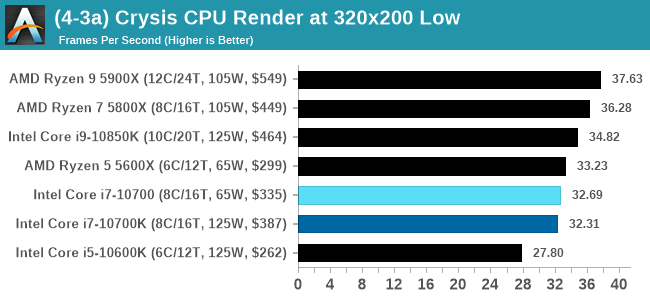
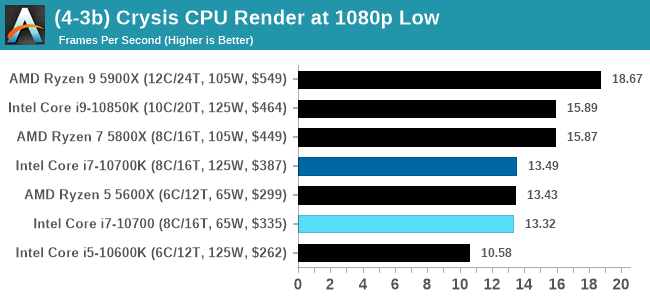
Almost playable.
POV-Ray 3.7.1: Link
A long time benchmark staple, POV-Ray is another rendering program that is well known to load up every single thread in a system, regardless of cache and memory levels. After a long period of POV-Ray 3.7 being the latest official release, when AMD launched Ryzen the POV-Ray codebase suddenly saw a range of activity from both AMD and Intel, knowing that the software (with the built-in benchmark) would be an optimization tool for the hardware.
We had to stick a flag in the sand when it came to selecting the version that was fair to both AMD and Intel, and still relevant to end-users. Version 3.7.1 fixes a significant bug in the early 2017 code that was advised against in both Intel and AMD manuals regarding to write-after-read, leading to a nice performance boost.
The benchmark can take over 20 minutes on a slow system with few cores, or around a minute or two on a fast system, or seconds with a dual high-core count EPYC. Because POV-Ray draws a large amount of power and current, it is important to make sure the cooling is sufficient here and the system stays in its high-power state. Using a motherboard with a poor power-delivery and low airflow could create an issue that won’t be obvious in some CPU positioning if the power limit only causes a 100 MHz drop as it changes P-states.

V-Ray: Link
We have a couple of renderers and ray tracers in our suite already, however V-Ray’s benchmark came through for a requested benchmark enough for us to roll it into our suite. Built by ChaosGroup, V-Ray is a 3D rendering package compatible with a number of popular commercial imaging applications, such as 3ds Max, Maya, Undreal, Cinema 4D, and Blender.
We run the standard standalone benchmark application, but in an automated fashion to pull out the result in the form of kilosamples/second. We run the test six times and take an average of the valid results.
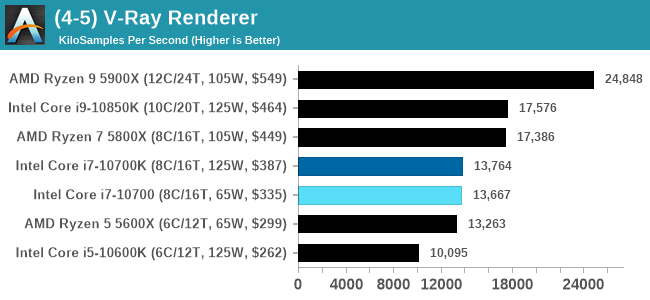
Cinebench R20: Link
Another common stable of a benchmark suite is Cinebench. Based on Cinema4D, Cinebench is a purpose built benchmark machine that renders a scene with both single and multi-threaded options. The scene is identical in both cases. The R20 version means that it targets Cinema 4D R20, a slightly older version of the software which is currently on version R21. Cinebench R20 was launched given that the R15 version had been out a long time, and despite the difference between the benchmark and the latest version of the software on which it is based, Cinebench results are often quoted a lot in marketing materials.
Results for Cinebench R20 are not comparable to R15 or older, because both the scene being used is different, but also the updates in the code bath. The results are output as a score from the software, which is directly proportional to the time taken. Using the benchmark flags for single CPU and multi-CPU workloads, we run the software from the command line which opens the test, runs it, and dumps the result into the console which is redirected to a text file. The test is repeated for a minimum of 10 minutes for both ST and MT, and then the runs averaged.

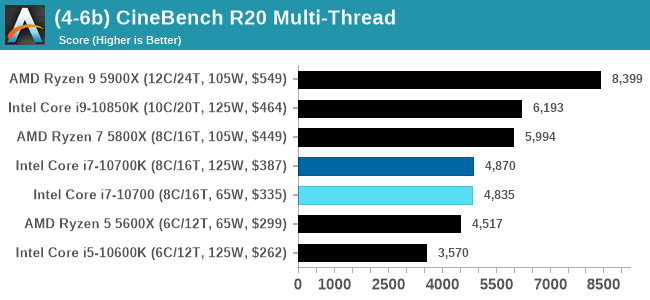
We are still in the process of rolling out CineBench R23 (you can see the results in our benchmark database here), but had not tested it on all the CPUs in this review at this time. It will be added to future reviews.




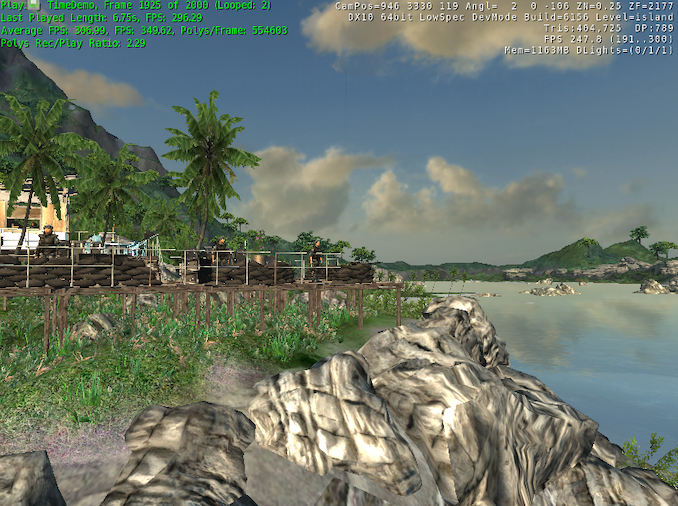











210 Comments
View All Comments
bji - Tuesday, January 26, 2021 - link
Well I guess it's a difference of opinion about what "general availability" means. If most people who are not within direct driving distance of a MicroCenter are having a hard time finding these chips, then I would call that not "general availability". I did admit that I overstated the low number of people who are in driving distance to a MicroCenter, but I still contend that it's a low number relative to the total number of people who want to buy these chips. We could start arguing now about who is TRULY within reasonable driving distance of a MicroCenter -- if you have to drive 1 hour to get the chip, is it really still generally available? If your time is even worth $15/hr minimum wage, that's adding a significant cost in the dollar value of your time to the cost.But I really don't want to argue about it any more. I still think these chips are not generally available and posting an article that compares one to to another when one or both are not easy to get for the vast majority of people, is disingenuous as it presents choices that do not practically exist. If you disagree, then that's fine.
Spunjji - Wednesday, January 27, 2021 - link
It's not a difference of opinion, it's a difference in perspective. I don't even care about MicroCenter because I'm not from the USA. These chips have "general availability" in the EU and UK at the very least, so I appreciate the comparison - as will many other peopleThis article will be around longer than demand continues to outstrip supply in the USA, and maybe even long enough to see $15 an hour become the minimum wage there. 👍
brucethemoose - Thursday, January 21, 2021 - link
Maybe they'll go the route of GPUs and just stop advertising TDPs entirely?This whole system works because most desktop users don't seem to care about TDP or power consumption. Performance at the absolute extreme end of the frequency/voltage curve is all that seems to matter.
Mr_Spock - Thursday, January 21, 2021 - link
I appreciate the testing, showing that with most other things 'equal', there is effectively little difference between the 10700/K.Would you consider running any tests with a 65W-class cooler to demonstrate exactly how performance is damaged by only matching the TDP on the box?
Having the full-bore tests for 10700 is quite useful if you can't find the K at a decent price, but if we're talking about quoted TDP 'limits', let's try limiting to that heat dissipation and see how quickly it flops.
I built a few Haswell systems back in the day, and whoo boy, were those stock coolers ineffective if you got any decent chip under it.
DominionSeraph - Thursday, January 21, 2021 - link
Eh? The stock cooler on the 4770 was fine. They only pulled 50W. I have no idea what you mean by "any decent chip under it" since there was only the 4770 and 4790 at the top and their wattage was about the same. (my 4790 was undervolted a tad and was 50W)Mr_Spock - Thursday, January 21, 2021 - link
Running prime95 on a stock cooler with a 4770 sent temperatures skyrocketing in my experience (80+C). I might have had too-high standards for cooling, since I always recommended at least a 212 EVO or better when it would fit into the cases we used. My employer used cheap cases that didn't come with an exhaust fan by default - installing 1+ case fans was always a recommendation for anything generating a lot of heat if I could convince the customer how much it was needed.Sounds like our use cases might be different? Or, you might have superior case cooling. All I know is we always had more tolerable temps once dumping the included cooler for something more suited to very heavy work.
vegemeister - Friday, January 22, 2021 - link
80°C is safe. Read the Haswell datasheet. The embedded controller won't even tell you to start spinning up the fan until 80°C idle. https://www.intel.com/content/dam/www/public/us/en...quiq - Sunday, January 24, 2021 - link
now using a 4590 whit aftermarket cooler ambient temperature now is 34°C/93°Fhttps://ibb.co/NKYXx6T
I have to upgrade because whit the itb heatsink run over 60°C/140°F all the time
geokilla - Thursday, January 21, 2021 - link
One reason to go for the K series is for faster RAM and the possibility of overclocking it to 5GHz. Shame there's no overclocking vs turbo results.Naine - Thursday, January 21, 2021 - link
You keep talking about how the TDP means nothing in the context of peak power draw, but it has nothing to do with peak power draw. That is only restricted by PL2, which is probably well over 200W for that chip, and like you say, motherboards can come up with their own PL2 values, especially if you slot this into the same high-end Z490 board you bought for your K CPU. Different story if you put it in a low-end B460 board.Here's what "65W TDP" means: If you pair this CPU with a 65W cooler, it will work.
That's literally what it means.